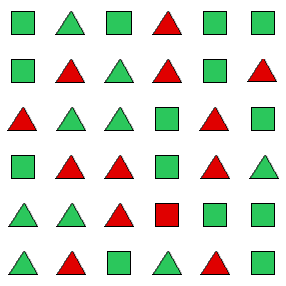Perception and Action
121
Learning Objectives
Know what the conjunction search task is.
Know that attention is required for feature binding, relating to the parietal cortex.
Conjunction search task is a process of identifying a desired object when it is in close proximity to objects that share some of its same features. Humans engage in conjunction search tasks every day—for example, looking for a specific pencil in a pouch full of them. Every pencil shares similar features to the one you are looking for (the length, the color, the sharpness, etc.), so to find the one you want, you must systematically critique each one, matching its features to the feature combination you want.
In order to do this, binding has to occur. Binding is a feature of attention that involves associating the individual characteristics of an object with each other. Using the figure below, this entails associating the shape (square) with its color (red) and recognizing it as the features of one thing (a red square) rather than two distinct things (red and a square).

The mental processes of conjunction searching and binding are facilitated by the parietal cortex. This area in the brain plays a key role in exercising attention, which is crucial for binging and conjunction searching. Without attention, you would not be able to identify the pencil you were looking for because they would all look too similar. In fact, you might even grab the wrong pencil because you associated the red of the pencil you wanted with a pencil near it that is not the same color!
The perceptions derived from conjunction and binding are not always accurate which can be illustrated in baseball. In baseball, curveball pitches can produce an illusion to the batter as a result of accidental feature binding (feature blurring) in peripheral vision. This gives the batter the wrong impression of the ball’s trajectory if the batter does not look directly at the ball.
In this video, you can learn more about the binding problem.
Cheryl Olman PSY 3031 Detailed Outline
Provided by: University of Minnesota
Download for free at http://vision.psych.umn.edu/users/caolman/courses/PSY3031/
License of original source: CC Attribution 4.0
Adapted by: Joey Kloncz & Jarod Davis
References:
[1] Kesner, R. (2012). “Parietal lesions produce illusory conjunction errors in rats”. Frontiers in Integrative Neuroscience.doi:10.3389/fnint.2012.00022.

